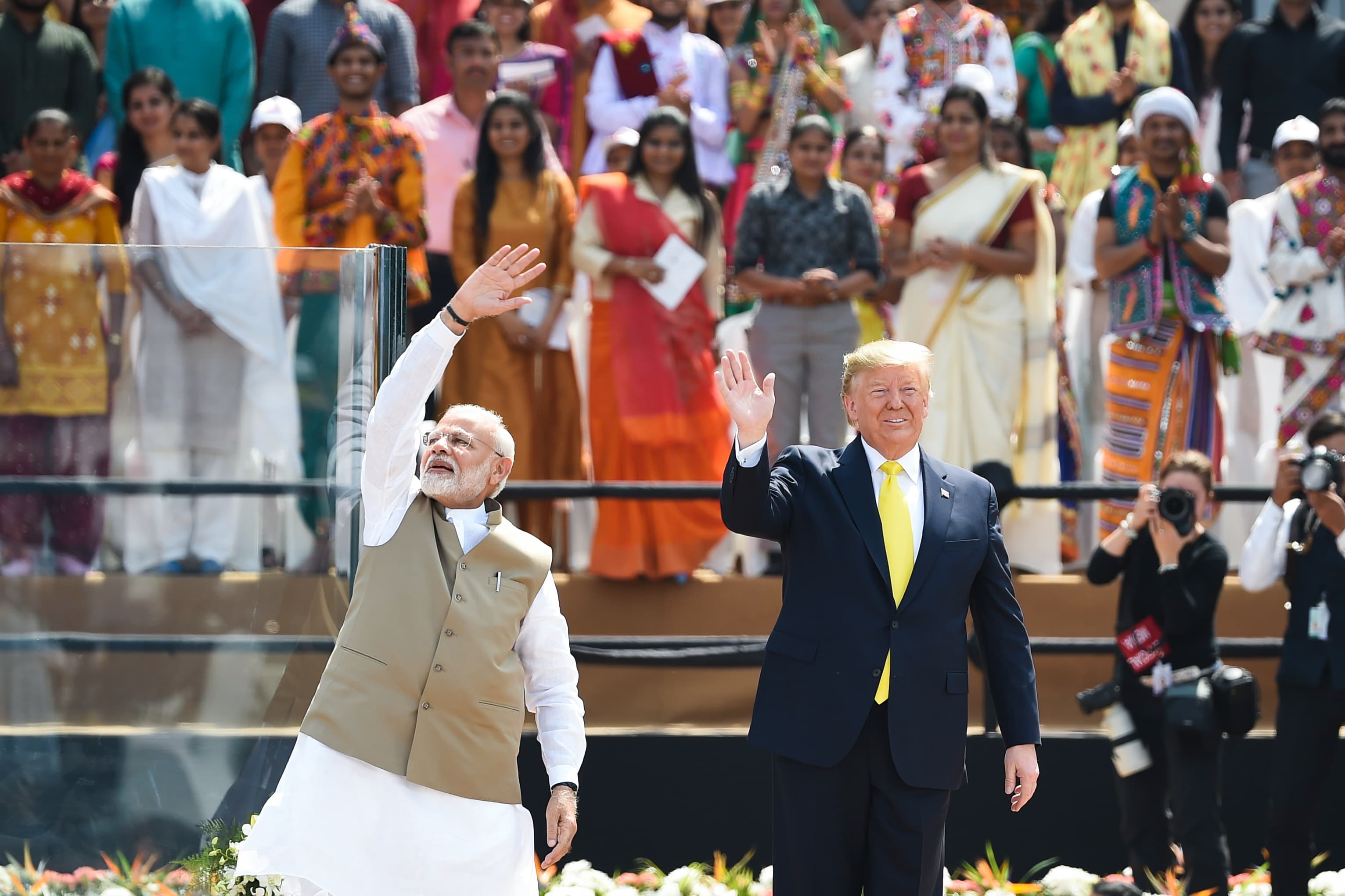
US President Donald Trump (R) and India's Prime Minister Narendra Modi wave at the crowd during 'Namaste Trump' rally at Sardar Patel Stadium in Motera, on the outskirts of Ahmedabad, on February 24, 2020.
Money Sharma | AFP | Getty Images
The rivalry between the U.S. and China is playing out in India, where American President Donald Trump will be wrapping up his state visit to the South Asian country.
Experts said that Trump's first state visit to India signifies the growing strength of the relations between Washington and New Delhi, amid China's rising clout in South Asia. As part of his two-day visit which began on Monday, Trump was in New Delhi and Ahmedabad, the largest city in Indian Prime Minister Narendra Modi's home state of Gujarat.
The fact that Trump made time for India in an election year is a major win for the South Asian country, said Richard Rossow, senior advisor and the Wadhwani Chair in U.S.-India Policy Studies at the Center for Strategic and International Studies, a Washington D.C.-based think tank.
U.S.-India trade is "defying gravity" and continues to grow despite trade barriers on both sides, Rossow told CNBC.
"India is choosing — even as it puts trade barriers — to buy more from the United States in those sectors where the government of India makes the buys," said Rossow, referring to state purchases in gas and defense sectors as examples.
One area where India and the U.S. have increased co-operation is defense procurement. India recently approved plans to purchase 24 military helicopters worth $2.6 billion from American defense firm Lockheed Martin for the its navy, local media reported.
India's longstanding defense supplier has traditionally been Russia. But in recent years, New Delhi has inked more and more defense deals with Washington, with purchases from the U.S. reaching $17 billion since 2007, according to Reuters.
India was one of the top five military spenders in 2018, along with the United States, China, Saudi Arabia, and France.
'Tie that binds'
The Trump administration has championed the use of the term "Indo-Pacific" rather than "Asia Pacific" as it seeks to balance the rising power of China in the region. The Indo-Pacific strategy would place India at the center of the playbook.
"China — at least on the defense and security relationship — is the tie that binds us together," said Rossow.
Although Washington has been trying to engage India for sometime regarding closer security ties, New Delhi has been slow to respond till recently, said Rossow, pointing out that China is "playing a more active role across South Asia and the India Ocean region." The Chinese navy has also been an active operator in the Indian Ocean region, and has sent submarines to the region, he added.
And India is beginning to feel the heat as Beijing has not only built up strong relations with Sri Lanka, Pakistan, Nepal, Bangladesh and Maldives, but China's economy and military are also bigger than India, he said.
The underlying reasons for the security partnership between the U.S. and India are beginning to appear more complementary now, said Rossow.
Taking sides
Like many countries, India is finding itself caught between the world's two largest economies.
One area the U.S.-China rivalry is playing out is in the area of technology, where both countries are vying to be the leader in 5G — the next generation mobile networks that promise super-fast data speeds.
The competition could also create what has now been dubbed the "splinternet" — a future in which the internet is fragmented, governed by separate regulations and run by different services.
"The technology world, the internet itself is beginning to fault," said Jayant Sinha, standing committee on finance in parliament, chairman and former Indian minister for finance and aviation.
"India needs to decide which side it's on," Sinha told CNBC's Tanvir Gill.
He acknowledged that the U.S. is putting "a lot of pressure" on other countries to "follow its path, not the China path," but there are other considerations as both Washington and Beijing have made vast technology investments in India.
As India builds its own technology ecosystem, the South Asian nation also has to "navigate between these two poles that are rapidly starting to emerge," said Sinha.
https://news.google.com/__i/rss/rd/articles/CBMiamh0dHBzOi8vd3d3LmNuYmMuY29tLzIwMjAvMDIvMjUvdHJ1bXAtdmlzaXRzLWluZGlhLWFzLW1vZGktYWRtaW5pc3RyYXRpb24tYmFsYW5jZXMtdXMtY2hpbmEtcmVsYXRpb25zLmh0bWzSAW5odHRwczovL3d3dy5jbmJjLmNvbS9hbXAvMjAyMC8wMi8yNS90cnVtcC12aXNpdHMtaW5kaWEtYXMtbW9kaS1hZG1pbmlzdHJhdGlvbi1iYWxhbmNlcy11cy1jaGluYS1yZWxhdGlvbnMuaHRtbA?oc=5
2020-02-25 09:22:00Z
52780621541497
Tidak ada komentar:
Posting Komentar